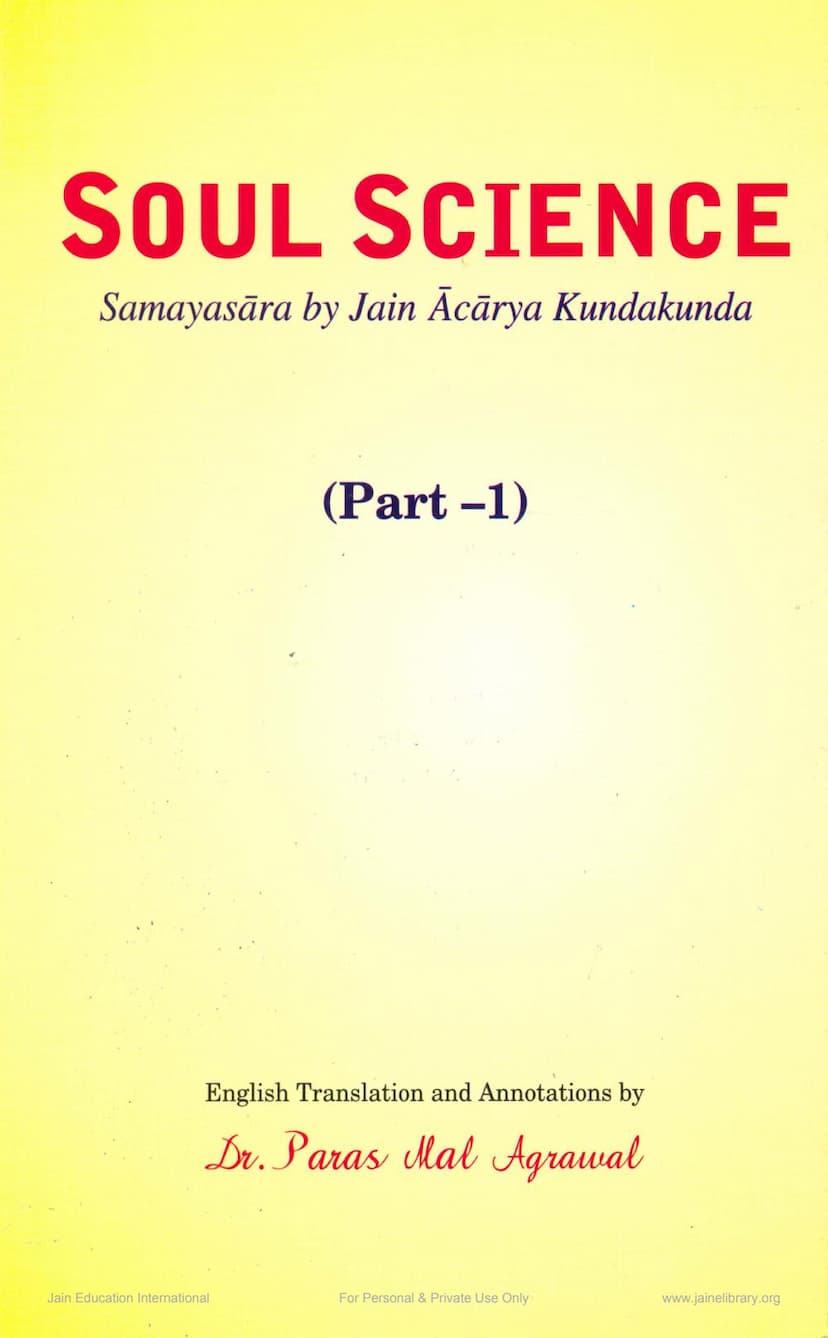Soul Science Part 01
Added to library: September 2, 2025

Summary
This document is the first part of an English translation and annotation of the Jain scripture Samayasāra, originally authored by Ācārya Kundakunda (circa 2nd Century AD). Titled "Soul Science Part 01," the book is translated and annotated by Dr. Paras Mal Agrawal. The publisher is Kundakunda Jñānapitha, Indore.
Core Theme: The primary aim of Samayasāra is to elucidate the true nature of the soul (Jiva). Ācārya Kundakunda meticulously and logically distinguishes the eternal soul from its transient associations, such as the physical body, pleasures, pains, emotions, and worldly possessions. The ultimate goal for the soul, as presented in the text, is to realize its inherent "I-ness" within its essential nature (Samayasāra), leading to bliss, peace, and happiness.
Author and Translator: Dr. Paras Mal Agrawal, a physicist by training with extensive research experience in the USA, brings a scientist's perspective to the spiritual text. His annotations aim to explain the stanzas using modern scientific examples and logical reasoning, making the complex Jain philosophy accessible to a contemporary audience. He also draws upon classical commentaries by Ācāryas Jayasena and Amṛtacandra.
Significance of Samayasāra:
- Samayasāra is considered the magnum opus of Ācārya Kundakunda and is highly revered in Jainism, particularly among the Digambara tradition. Ācārya Kundakunda's name is invoked with great respect after Lord Mahāvīra and his chief disciple Gautama Gañadhara before any auspicious undertaking.
- The scripture was originally written in Saurseni Prakṛta and has been the subject of numerous commentaries and translations over centuries.
- The book aims to fill a need for an English translation with detailed annotations that connect the scripture's teachings to modern life, address apparent contradictions between different Jain philosophical perspectives (Naya), and explain complex concepts in a simple, scientific, and logical manner.
Content and Approach (Part 1): This first part covers the initial 144 stanzas of Samayasāra, which include:
- Introduction: Setting the stage and explaining the purpose of the scripture.
- Chapters on Soul (Jiva) and Non-Soul (Ajiva): Defining and distinguishing between the soul and all other substances.
- Chapters on the Doer (Kartā) and the Deed (Karma): Exploring the nature of agency, action, and karmic bondage from both real (Niscaya Naya) and relative (Vyavahāra Naya) viewpoints.
Key Concepts and Illustrations: The book uses analogies from modern science and everyday life to illustrate profound Jain concepts:
- Dravya (Substance): The eternal and unchanging nature of substances, like Pudgala Paramāņu (fundamental particle of matter), is compared to that of the soul.
- Naya (Points of View): The text emphasizes the necessity of understanding both the real (Niscaya Naya) and relative (Vyavahāra Naya) perspectives to grasp the complete truth, akin to understanding a house from multiple blueprints or a king in relation to his kingdom and his soldiers.
- Cause and Effect: Scientific principles of energy conservation and chemical reactions are used to explain how matter and soul, while interacting, do not fundamentally change their inherent nature.
- Doership: The concept of "doer" is clarified, distinguishing between the substantial cause (Upādāna) and the instrumental cause (Nimitta). The soul is the doer of its own spiritual states (Bhāva), but the transformation of matter into karma is explained through the interplay of the soul's actions (as Nimitta) and matter's inherent nature (Upādāna).
- Purity of the Soul: The soul, by its inherent nature, is pure and unchanging, unaffected by external conditions or karmic attachments, even though its manifested states (Paryāya) might appear otherwise.
Structure and Features:
- The book includes original stanzas in Devanagari script, English transliteration, and Sanskrit versions.
- Appendices provide essential resources: a glossary of Sanskrit/Hindi terms, explanations of concepts like Arahanta, Siddha, and God, definitions of six substances (Dravya), scientific examples, and the doctrine of Karma.
- The translation aims for simplicity and clarity, making the deep philosophical concepts accessible to a wider audience.
Overall Aim: "Soul Science Part 01" is presented as a guide for those seeking spiritual knowledge, peace, and happiness, offering a scientifically-backed and logically reasoned approach to understanding the eternal nature of the soul as taught by Ācārya Kundakunda. The publication is a significant contribution to making Jain spiritual literature available in English for a global audience.